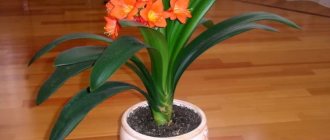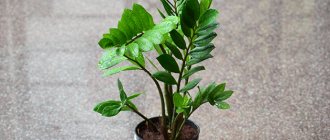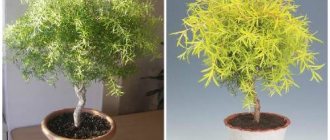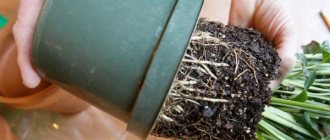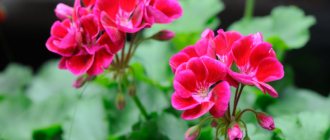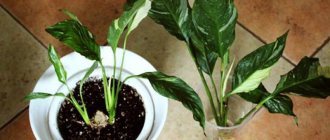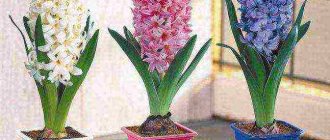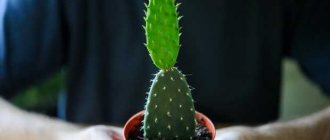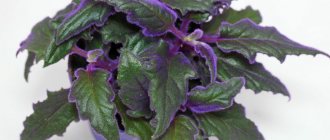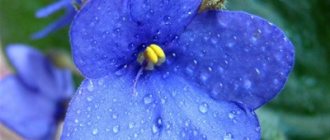During flowering, clivia surprises others with a high arrow with many flowers on it. Naturally, every gardener will want to have as many of these plants as possible. A flowerpot with an exotic plant can be presented as a gift to loved ones.
You can propagate any type of clivia in the following ways:
- using seeds;
- root shoots (children);
- dividing the bush.
First, you need to decide on the container in which the tropical miracle will grow and its contents.
Propagation of clivia by side shoots
This method of propagating a blooming beauty is the most reliable and simplest. In a pot with an adult plant, over time you can find small sprouts on the sides. These are the “babies” that should be removed from the mother part of the flower when they already have four strong leaves.
The process of planting side shoots must be carried out by adhering to simple but mandatory rules:
- each shoot should have 3-4 leaves;
- the plant can be disturbed only after the end of its flowering period for the current year;
- the “babies” should be separated carefully, taking care to preserve the integrity of the roots of the mother flower system and young shoots;
- accidentally injured roots should be covered with a layer of wood ash in the areas of damage.
The shoots are planted in personal pots 7 cm in diameter. For an adult flower, a small pot is also used. The root system of clivia loves close quarters . With this condition of the roots, the leaves of the flower grow fleshier and richer green.
The first two days after planting, the plant is not watered and kept warm at 20-25 degrees. Then moderate watering is gradually resumed. Young plants will bloom for the first time in 2-3 years.
Propagation by seeds
The next method is more suitable for ideological people who are in love with floriculture. It is less efficient and more labor-intensive, but also more interesting. It becomes especially interesting if you already have several Clivias of different colors at home. In this case, you can try to get a hybrid of these two plants and feel like a real breeder.
Preparation
Of course, you can simply buy seeds in a store, but then they will require special preparation for planting . It involves soaking the seeds before planting in the ground.
But seeds obtained from the mother plant do not require soaking, and receiving them is much more interesting. During flowering, Clivia is cross-pollinated; it is possible to pollinate different flowers of the same plant, or pollinate two different Clivias. Readiness for pollination is determined by the flower itself.
When a small drop appears on the stigma of the pistil and the stamens begin to fall off, you can begin pollination. To do this, carefully move a damp cotton swab or toothpick along the stamen so that some of the pollen remains on the instrument, and why transfer it to the top of the pistil.
If pollination was successful, the flower will begin to fade, and a green ovary will form at its base . It is this that later forms the fruit. One plant can have several fruits at the same time, which will not interfere with each other’s development, but can spoil its appearance for some time. Over time, the Clivia berry will turn red and become soft, which will indicate its ripeness. But don’t rush to pick them before planting. It is recommended to plant seeds immediately from the fruit so that they do not have time to dry out.
Attention : Despite the attractive appearance of Clivia berries, they should never be eaten.
Sowing
The seeds are planted in a container with a nutrient medium, usually a mixture of sand, peat and turf. It is strictly observed that there is 2 cm between the seeds, and the planting depth is no more than 1-1.5 cm. If the seeds do dry out, then before planting in the ground they are kept for about a week in a warm place in a damp cloth or gauze. After 4-6 weeks, the first shoots will appear; in six months the plant can grow up to six leaves. With the appearance of the first leaves, the seedlings can be planted in separate containers. In the first year they are replanted twice, then once a year, increasing the diameter of the pot by 2-3 cm.
The first three years of Clivia do not allow a dormant period, allowing roots and leaves to grow . Young plants from seeds will bloom only after 4-5 years of life. Clivia is a poisonous plant; it is necessary that children and animals do not have access to the plant to avoid poisoning. After all manipulations carried out with the plant, you should thoroughly wash your hands and tools.
Seed propagation of plants
To propagate a plant by seeds, the easiest way is to purchase them in a specialized store. If you want to get seeds with your own labor, flowering clivia must be artificially cross-pollinated. To do this, use a thin watercolor brush to take pollen from one flower and carefully place it on the pistil of another flower. Thus, in a blooming clivia umbrella, which has about 60 flowers, half of them will be pollinated, and half will remain a source of pollination.
If the process is successful, then berries will form at the end of flowering. At first they will be light green, and as they ripen they will darken to a brownish hue. Each ripe berry contains 4-5 seeds. This method of propagating clivia gives a guarantee of 1/3 of all flowering specimens received.
Which method is more effective?
The effectiveness of various propagation methods depends on the desired result.
If it is necessary to obtain a large number of young plants, and the timing of flowering does not matter, choose seed propagation. On the contrary, if you need to get flowering young plants in small quantities, you need to propagate clivia vegetatively. Propagation of clivia by children is simpler and less labor-intensive .
As a rule, children bloom already in the 2nd year after separation from the adult specimen. But clivias don’t have that many lateral shoots, so you shouldn’t count on getting a lot of young plants through vegetative propagation.
It is difficult to propagate clivia by seeds , since in order to obtain them, it is necessary to pollinate the flowers of the plant.
But each fruit contains a large number of seeds, so there will be no shortage of young plants. True, they grow very slowly and bloom only in the 4th year.
Clivia: planting and care (video)
Planting seeds in the soil has preliminary measures and subsequent rules:
- soak the seeds for a day in warm water, leaving them in a warm place to swell;
- plant the seeds in a box with a properly prepared soil mixture, to a depth of 1 cm, at a distance of 2 cm from each other;
- covered with film or glass, creating a greenhouse. provide moderate watering and a temperature of 20-25 degrees;
- If necessary, the seed box is ventilated by removing the greenhouse cover and watered a little.
After 1.5 months, the first shoots will appear. When one strong leaf is formed on each sprout, they are planted in separate pots with soil from the mixture:
- deciduous soil (2);
- clay soil (1);
- humus (1).
Now young flowers are cared for like adults, but they are left with a little more warmth. Clivia from seed develops very slowly:
- The first year - 2-3 new leaves appear.
- Second year – 3-4 pairs of leaves will be added.
- The third year and beyond - 2 pairs of new leaves per year.
Clivia will bloom for the first time only after 5-6 years.
Brief description of cultivation
- Temperature regime . In summer - around 25 degrees, and in winter - from 12 to 15 degrees. After the first bud is formed, the bush is moved to a warmer place.
- Air humidity . About 40 percent. Too low air humidity does not harm the flower. Systematic moistening from a spray bottle is recommended.
- Illumination . The light should be bright, but diffused. Western and eastern window sills are best suited.
- Watering . After the buds are clearly visible, the plant is provided with abundant watering. In the summer months, the bush is watered once a week, and in the winter - once every 1.5 weeks.
- Substrate . A ready-made universal soil mixture for indoor plants is used. Mix humus, turf soil and peat in a 1:2:1 ratio. A high-quality drainage layer is laid at the bottom of the container.
- Fertilizer . Feeding is carried out from the first days of spring until the end of summer 2 times a month. To do this, use a universal liquid fertilizer for flowering plants. No fertilizing is carried out during the winter months.
- Transplant . While the bush is young, it is replanted every year, and older specimens - as needed. After transplantation, the bush is sick for a long time. For large adult clivia, it is recommended that instead of replanting, regularly replace the top layer of the soil mixture with fresh one.
- Reproduction . By shoots and seed method.
- Features of care . When the bush fades, you must cut off the peduncle at the base. If seeds form on the bush, this may cause a lack of flowering and growth cessation in the next season. The plant does not react well to being moved to a new location. This can also cause the bush to refuse to bloom.
Houseplant Clivia - Kaffir lily | A favorite of flower growers. An unpretentious plant - a holiday.
Reproduction technology by dividing the bush
This method is applicable at the time of transplantation. In this case, the root system is divided into equal parts, and the cut areas are covered with a layer of charcoal. The plants are placed in pots filled with the correct soil mixture and not watered for the next three days. Then resume modest watering. The soil should dry out well between each watering.
Flowering of clivia, propagated by dividing the bush, will resume only after a few years.
The flowerpot matters
The clivia pot should not be too large. The flower has one peculiarity - it first fills the entire space with roots, and only then begins the flowering process. In a container that is too large, all the energy will be spent on the formation of the root system, and there will be no left for leaves and flowers.
It is advisable to choose a cone-shaped flowerpot. This will make it easier to remove the root system during transplantation without damaging it. The material for the container is plastic. Drainage holes can be easily made in such a pot.
Recommended soil mixtures and growing conditions
The soil in the clivia pot should be loose and slightly acidic. The best mixtures would be:
- turf soil (2) + humus (1) + peat (1);
- turf soil (1) + peat (0.5) + sand (1);
- turf soil (1) + leaf soil (1) + humus (1).
Clivia loves light and warmth, but leaving her in the hot sun is destructive. It is better to place a flower pot on the windowsill of an east or west window. On the south side of the house, clivia must be protected from direct sunlight at midday. In summer, it is useful to take the flower out into the garden or onto the balcony, leaving it there in the fresh air in partial shade.
Types of clivia
Clivia Vermilion is not the only type of this indoor flower. Her sisters are Clivia Gardena and Clivia the Beautiful.
Breeders from time to time delight with new varieties of this flower. In the photo you can see the stunning colors and shapes of clivia.
Some flower lovers grow several varieties of plants at home, adjusting the flowering period in such a way that one of them blooms almost constantly in the house.
Propagation of clivia by seeds (video)
Watering clivia should be moderate so that the soil has time to dry out well. If water collects in the pan during watering, it must be drained to avoid root rotting. You should not spray the flower. But when the leaves become covered with dust, they are carefully washed with a soft, damp sponge.
Clivia is fed every two weeks from the moment it is in the pot. For this purpose, use organic and mineral fertilizers for indoor leafy plants, strictly observing the dosages indicated on the packaging.
The resting period of Clivia lasts from September to November. During this period of time, the flower is placed in a cool place and watering is completely stopped. In this case, the leaves may turn yellow and fall off, which is a natural process of overwintering the plant.
Characteristics of clivia
The most common variety in home floriculture is Clivia cinnabar.
- Although it belongs to the Amaryllis family, it produces rhizomes instead of the bulbs characteristic of the family.
- The flower has no stem: evergreen leaves grow on top of each other, resembling a fan. The number and size of foliage depend on age: a 14-year-old has up to 24, length - up to 70 cm, width - up to 7 cm.
- An inflorescence with a diameter of up to 20 cm on a high peduncle (up to 30 cm) can consist of 12-26 flowers (deep orange with a yellowish base with a diameter of up to 8 cm), each with six petals arranged in two rows.
- 40 years is the age of a long-lived clivia, subject to all the nuances of cultivation.
Possible problems in development and ways to solve them
If you take proper care of your clivia, it will feel great. But it happens that clivia leaves dry out, turn yellow or become stained, trying to signal errors in its maintenance:
- The leaves dry out and wrinkle, indicating overdried soil. We must not forget about watering the flower.
- Rot spots on the leaves, their yellowing and falling off during the active state of the plant, indicate excess moisture in the roots. To save the flower, it urgently needs to be transplanted into a new substrate and henceforth do not exceed the permissible watering and allow the soil to dry well.
- Dry spots on the leaves are sunburn on clivia. The flower must be removed from direct summer sunlight, which burns it.
Possible problems
If clivia is not provided with suitable conditions for growth or is not properly cared for, this can lead to the following problems:
- Rot on the roots . Stagnation of moisture in the substrate. Replant the bush by cutting out all affected parts of the roots. Adjust the watering mode.
- Flowers are flying around . The bush is often moved from one place to another.
- Lack of flowering . Poor lighting or keeping the bush warm in winter.
- Light-colored spots appeared on the foliage . This is a sunburn. Cut off all injured leaf plates, do not forget to shade the flower from direct rays of the sun.
- Brown spots have formed on the foliage . During watering, droplets of water fall on the leaves, while the plant stands in the sun. Watering is carried out very carefully and is done in the evening or early morning.
- The peduncle has grown very short . During its formation, the bush felt a lack of moisture or the room was too cold. Water it promptly and move it to a warm place.
- Yellowing and drying of foliage in autumn . This is a completely natural process.
- Twisting sheet plates . The plant is watered too sparingly or rarely.
- Stopping the growth of the bush. The room temperature is too low or too high.
- Faded foliage . The plant needs urgent feeding.
- The tips of the leaf blades become brown . Too much or frequent watering. Let the substrate dry well without moistening it for several days, or replant the bush into fresh soil mixture.
- Peduncles are not formed . The plant experiences an acute lack of nutrients.
- Rot appeared at the base of the stem and lower leaf blades . During transplantation, the root collar was buried + regular stagnation of moisture in the substrate. Replant the bush without deepening the root collar, cut out the rotten parts of the bush, and adjust the watering regime.
- Scanty flowering . The plant needs urgent feeding.
- Pests . Homemade clivia is most often inhabited by mealybugs, false scale insects, scale insects and aphids. To destroy them, special insecticidal agents are used.
Flower varieties
At the moment there are 23 varieties of this flower. Main types and their distinctive features:
- Clivia miniata. The bush has a basal rosette with long, sharp, dark green leaves. The leaves have oblong stripes of white or yellow color. The length of the foliage reaches 60 cm. The height of the bush varies between 45-50 cm. During flowering, inflorescences with funnel-shaped buds of a red hue are formed. Clivia miniata is most often grown by gardeners;
- Lemon clivia (Clivia miniata Citrina). The bush is very similar to the cinnabar variety. The main difference is the creamy yellow color of the leaves. The resulting berries also have a yellowish tint;
- Clivia nobilis (Clivia nobilis). This is a perennial stemless plant with leaves collected in a rosette that look like a sword. Umbrella-shaped or racemose inflorescences of 14 pieces are formed from bell-shaped flowers. The flowers are orange with a pinkish tint. The height of orange clivia can be 30-50 cm.
For your information! The genus of the flower was named by the English botanist D. Lindley, who described the plant, in honor of the Duchess Charlotte Clivia.
Useful tips (note to florist)
Although clivia is a very unpretentious plant, let us give you some tips that will be useful to those who grow it at home.
- Do not place clivia on a north-facing window sill. The leaves will begin to turn yellow, growth will slow down and flowering will stop.
- When planting clivia with suckers, there is a greater risk of root rot than when sowing with seeds.
- Clivia can be used for anti-aging procedures. If the plant has grown greatly, you can remove the lower leaves and old roots.
Answers to readers' questions
Lifespan of a flower
Clivia lives a long time - up to 40 years. If you take care of it, it will bloom just as long.
Is this flower poisonous?
Clivia is a rather poisonous plant, so it is not recommended to keep it in children's rooms. Its milky sap is poisonous, so planting and replanting must be done with gloves.
Why doesn't clivia bloom?
If clivia has stopped blooming, then the place is not suitable for it - it is too dark or the dormant period is not organized correctly.
Why do the leaves turn yellow (dry, rust)?
If only the lower leaves turn yellow, this is a process of plant growth when a new one grows to replace the old lower leaf. If all the leaves turn yellow, this is a sign of lack of watering or too much watering. If this is an overflow leading to rotting of the roots, then the flower will have to be saved by digging it up and removing the rotten roots. After which it needs to be planted in new soil.
Why doesn't clivia grow?
Slow growth of clivia may be due to lack of light or exposure to pests.
How does the plant overwinter?
In winter, the plant rests, but only until February. At the beginning of February, the flowering period begins, and increased care is required.
Clivia is a relative of the popular amaryllis. However, it is devoid of a bulb; instead, the plant has a strong short stem and powerful thick roots. Clivia reproduces slowly.
Varieties of clivia with photos
Only three varieties of this tropical flower are grown in culture.
Clivia Gardena
A medium-sized species, reaching half a meter in height in adulthood. The leaves have a characteristic dark green color, leathery, long, with indistinct points at the ends. Flowering occurs in January-February; a tall powerful peduncle shoots out from the center of the flower, on which orange-red bell-shaped flowers bloom, collected in an umbrella-type inflorescence.
Clivia cinnabar
This species is the most common among decorative varieties. Its second name is Mminiata. In the dormant phase, it is almost impossible to distinguish it from other varieties: the same long, leathery, belt-shaped leaves are dark green in color, the same pyramidal shape of the crown. But when flowering begins, Clivia cinnabar blooms orange-red buds with a characteristic yellow transition of the petals at the base of the throat. Up to 20 flowers can be formed on one peduncle. It is cinnabar clivia that is the basis for the work of breeders to develop new varieties and hybrids of this beautiful tropical flower.
Clivia is beautiful
The length of the leaves of this variety is inferior to the previous type; they rarely extend more than 40 cm. High above them is a half-meter peduncle bearing from 3 to 6 dozen buds in a racemose inflorescence. A distinctive feature of this species is the noticeable green in the color of the petals. The usual flowering time is the end of winter (secondary - in the second half of summer).
Feeding and fertilizing indoor flowers
Clivia should be fed only during growth and flowering. Any liquid complex fertilizer for indoor plants will do. Twice a month they are added to water for irrigation. You can alternate mineral and organic fertilizers.
Important! Do not overuse nitrogenous fertilizers. Leaf growth will increase, but flowering will be reduced.
Pests and diseases
Of the insect pests, clivia is affected by mealybugs, aphids or scale insects. Scale insects leave brown plaques on the leaves and stems - the calling cards of a pest that sucks cell sap from the plant, causing the leaves to turn pale and dry. Mealybugs deform the leaves, shoots and flowers of the plant. To combat all these pests, wipe the leaves with a soapy sponge, and then spray the plant with a fifteen percent Actellik solution (a couple of milliliters per liter of water).
From too frequent and too abundant watering, clivia can be affected by gray rot - a fungal disease that manifests itself as brown spots on the leaves of the plant. If the infection is superficial, spray the clivia with Bordeaux mixture, Topaz or Champion. If treatment with fungicides does not produce the desired effect, use copper-containing preparations of combined or contact action - cuprosate, vitriol.
Why doesn't clivia bloom?
Very often site visitors ask the question of how to make clivia bloom. But in order to find incentives, it is necessary to find out the reasons why clivia does not bloom. There may be several reasons: firstly, a warm winter, or rather, a period of rest spent in a warm room; secondly, non-compliance with the rules of the dormant period - abundant watering or unnecessary feeding at this time; thirdly, the cause may be an excess of nitrogen fertilizers, which promote the growth of greenery, but prevent clivia from flowering. Re-read the rules for growing a plant and determine where you went wrong.
Clivia leaves are turning yellow
If the lower leaves of a plant turn yellow and die and this happens during the dormant period, everything is in order, you are witnessing the natural course of things. But if the problem is not related to the rest period of the clivia, then your concern is justified. So, why does clivia turn yellow?
Sometimes this is a plant’s reaction to replanting, so you need to add a few drops of Kornevin or another root growth stimulant to the water for irrigation for one and a half to two months. But most often the problem is improperly moistening the clivia: you either do not water it enough, or, on the contrary, pour too much water, or do it too often. If watering is insufficient, this is easy to fix, but if you overdid it with moisture, you will have to change the substrate to save the flower, after cutting off the rotten roots and disinfecting all the cuts.
Sometimes clivia leaves turn yellow due to lack of nutrition. In a word, the problem is in violating the rules of caring for the plant - it’s in them, in the rules, that you look for the cause of the disease, and having discovered the cause, it’s not difficult to find its solution.
Clivia leaves are drying up
The tips of the leaves turn brown and dry, usually due to waterlogging of the soil. It is worth remembering that the rhizome of a plant is a repository of moisture reserves and other substances useful to the plant, so do not try to water the plant once for its entire life - in this matter, as in any other, you need to observe moderation.
Home care
To successfully grow clivia, you need to touch it as little as possible - this is one of the most important rules, which is very often violated out of ignorance. You can move a flower from place to place only in cases of extreme necessity and at transition points in the life cycle to ensure proper conditions for a period of active growth or dormancy. It is also not recommended to touch the soil outside of replanting, for example, to loosen it.
Light requirements
The flower is a fan of shaded places; sunny southern windowsills are contraindicated for it. It can be placed not on the windows, but near them; it will grow perfectly on the western or eastern side. But northern windows are still not suitable for it due to the complete lack of sunlight; here the kaffir lily may not bloom. The flower can be moved here only during its resting phase. In the summer, the plant will feel great outdoors in a semi-shaded and not very windy corner.
Temperature
Clivia makes special demands on the temperature content only in the inactive phase of the growing season. During this time, she needs to find a cool, shaded place where she can rest with the minimum necessary moisture. As mentioned above, with the release of the peduncle, for quality care it will need to be provided with warm and humid conditions.
Watering and humidity
The kaffir lily does not have any increased requirements for humidity. As for watering, it should be moderate, without stagnation of water. The amount of moisture and frequency of watering is adjusted depending on the life cycle.
Feeding
The active growth of a flower requires increased nutrition, therefore, at the first signs of awakening from hibernation, it needs to be fed every 2 weeks, using complex formulations for flowering indoor crops. When choosing fertilizers, you should pay attention to the reduced content of the nitrogen component, which can harm flowering due to the growth of foliage.
During the dormant stage, no fertilizers are applied to the soil. You should start fertilizing the flower no earlier than 2-2.5 months after entering the dormant phase, if you need to awaken it to bloom again.
Soil requirements
It is recommended to make a soil mixture based on turf soil with humus with the addition of 15-20% sand. High-moor peat would be a good addition to the soil mixture. Arrangement of a drainage layer of at least 3 cm is mandatory.
Clivia flowering, as often happens
A young culture blooms only once a year. After the plant matures, flowering occurs 2 times a year. At the end of the dormant period, a flower arrow forms. As soon as the height of the flower reaches approximately 14 cm, it is moved to a special place. It is necessary to take into account the room temperature, as well as provide abundant watering. The plant does not like to be touched a lot. Therefore, until the flower arrow has fully grown, you do not need to perform any actions with it. In addition, it should be taken into account that with a sharp change in temperature the buds will not bloom.
Aeonium: home care and main species of the family
After placing the crop in the room, you should provide it with abundant watering. When moisturizing clivia, you will have to use warm water. This must be done to activate the growth of the peduncle.
Important! Any movement of the flower pot during budding and flowering can cause a stop in their development.
When flowering is completed, you should not stop watering and fertilizing the plant: in summer there is a possibility of flowering. If this does not happen, then the culture will have to be provided with a period of artificial dormancy. It is necessary to choose a cool room for this. It is not recommended to feed the plant or to water it abundantly. After a few weeks, you will notice a positive result.
Sometimes flowering occurs without a dormant period. Due to its unpretentiousness, the culture adapts to any conditions. Therefore, clivia will bloom at least once a year.
You can take seeds from this flower, but only when using artificial pollination. They appear as green fruits. Then their shade changes and becomes red-orange. This can happen only after a while, for example, after a year. Seeds can be collected when the fruits become soft.
Features of the rest period
Noble clivia requires a period of rest. As a rule, it begins in October or November, lasting from 2 to 3 months. In the fall, the culture will have to be placed in a room where it is cool enough. Reducing watering is also recommended.
Applying fertilizer at this time is strictly prohibited. The temperature should be maintained around 10–12 degrees. If the leaves begin to turn yellow, then they need to be watered immediately.
Benefits and harms
Clivia is a very cheerful plant. Its bright flowers and luscious leaves create a wonderful mood and a sense of harmony, and it is also believed that the presence of clivia in the house normalizes the circulatory system.
The roots and leaves of Clivia cinnabar are actively used in pharmacology , and indigenous people of Africa use clivia for fever and as a pain reliever for poisonous snake bites.
IMPORTANT! It should be remembered that parts of the plant are very toxic! Replant the plant only with gloves on! Do not try to experiment with clivia treatment, it is very dangerous!
However, if you follow the simplest precautions and with proper care, clivia will delight you with beautiful flowers and fresh, bright leaves for a long time.
Which pot is best for the plant?
- The dishes should be taken in the shape of a cylinder. From the point of view of convenience, when handling, narrowed shapes are often preferred, from which it is easier to remove the plant. However, for the health and strength of the seedling itself, this particular shape is required, since the root system must develop downwards and rest against the walls of the pot on the sides. That is, it is necessary to allocate sufficient space for the development of roots.
- Clay pots are usually preferred, but in the case of clivia, which has a fragile root system that is vulnerable to rotting, it is better to take a plastic container or earthenware varnished on the inside. It is easier to remove the plant from such a pot.
- By the way, in the case when a plastic pot is used, it can simply be carefully cut when transshipment, thus protecting the roots as much as possible from damage and reducing the risks of rotting roots and drying of leaves after transshipment.
- The pot should have drainage holes to drain excess water.
Description of the houseplant Clivia
Clivia blooms every year if it is properly watered and not left in a warm room for the winter.
It needs a lot of space, and in winter it needs to be given a rest period in a cool room with very limited watering. Clivia does not like to be disturbed - they touch her too much and move her from place to place. Clivia is a very long-lived plant; under appropriate conditions, it can live up to 40 years. Old plants growing in tubs are not replanted, but only fertilized with fertilizers. The best specimens from old plants form up to 40-50 peduncles. The leaves of the plant, the decorative effect of which can decorate your interior even without flowering, are collected in a rosette and arranged in a kind of fan. The bright, cheerful orange inflorescences of clivia, set off by shiny dark green foliage, are extremely beautiful. Clivia flowers bloom in winter. Currently, various varieties of clivia have been bred: from light ocher to dark red flowers with a whole range of warm orange and yellow tones.
Clivia is a genus of perennial evergreen herbaceous plants of the amaryllis family (Amaryllidaceae). Botanist John Lindley named the genus in honor of the Duchess of Northumberland Charlotte Clive, governess of the future Queen Victoria of Great Britain. The genus Clivia includes approximately five species of plants in the amaryllis family.
Evergreen perennial herbaceous plants, stemless, multi-flowered. The leaves are vaginal, tightly covering each other, forming a false stem, linear or xiphoid. Under the ground, clivia develops a rhizome, to which thickened leaf bases and the leaves themselves are attached. Clivia is sort of in the middle between bulbous and rhizomatous plants. The flowers are bell-shaped, red or orange, collected in an umbrella.
One of the most common is Clivia miniata (lat. miniatus - painted with cinnabar, covered with red paint from lat. minium - cinnabar or red lead) - a perennial herbaceous plant of the genus Clivia of the Amaryllis family. In greenhouse and indoor culture it is used as a flower- and foliage-decorative potted plant. The plant's homeland is South Africa.
In the literature it is found under Russian names: orange clivia (matte red, meerkotsvetnaya, red lead), or kaffir (Cape).
